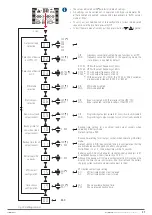
19
(3)
(2)
(1)
UPS
Input
Output
R (L)
U (L)
N
N
(1)
Automatic backfeed protection system external to the UPS (EN-IEC 62040-1).
(2)
Fuse holder and general purpose fuse 250V AC / 3A type F.
(3)
230V AC bipolar contactor with minimum contact spacing of 1.4 mm and coil
with same voltage and the minimum current indicated on the nameplate of
the UPS (input or bypass as appropriate).
For parallel systems, each device must have its own separate backfeed
protection.
Fig. 12.
Backfeed protection wiring diagrams.
5.2.2. Connection to IEC connectors or output terminals.
•
SLC TWIN RT2 devices feature female IEC output connectors
or terminals depending on the power of the model:
Models up to 2 kVA: 2 groups of 4 x 10A IEC
connectors identified as «OUTPUT» and «OUTPUT
PROGRAMMABLE (P1)», configurable through the
control panel and/or ViewPower.
3 kVA models: same connectors as models up to 2 kVA
and an additional 16A IEC connector.
4 to 10 kVA models: 1 group of output terminals.
In these models, a PDU (power distribution unit) is
supplied to connect to the output terminals of the
UPS. Through it, loads can be powered directly through
the two or three groups of 10 or 16 A IEC connectors
protected by a selective circuit breaker.
•
Do not connect loads that in their entirety exceed
the specifications of the device, as this would cause
inconvenient cuts in the power supply of the loads
connected to the output.
•
If, in addition to the more sensitive ‘critical loads’, it is
necessary to connect high-consumption inductive loads,
such as for laser printers or CRT monitors, the starting up
of these peripherals will need to be taken into account to
prevent the device from crashing.
We do not recommend connecting loads of this type due to
the amount of power they absorb from the UPS.
5.2.2.1. Connection of loads in models up to 3 kVA.
•
Connect the loads to the 10 A IEC connectors.
It is important to consider the two groups of IEC
connectors available, those for ‘critical loads’ and
those for ‘non-critical loads’.
By definition, ‘critical loads’ are considered to be those
that can cause economic damage if they stop functioning
or function incorrectly.
The IEC connectors indicated in Fig. 2 as ‘non-critical
loads’ can be programmed as such through the control
panel. In this case, the backup of the batteries for the
loads connected to the IEC connectors indicated in Fig. 2 as
‘critical loads’ will be reserved. Take into account that they
are set by default as ‘critical loads’.
•
The 3 kVA models also have a 16A IEC connector
that enables the connection of a load of the total
power of the device.
5.2.2.2. Connection of loads in 4 to 10 kVA 10 kVA.
•
As the device has Class I protection against electric
shock, it is essential to install a protective earth
conductor (connect earth (
)). Connect this conductor
before supplying voltage to the input terminals.
•
Connect the loads to output terminals
U (L)
and
N
,
respecting the order of the phase and the neutral
indicated on the labelling of the device and in this manual
(see Fig. 2). Where there are discrepancies between the
labelling and the instructions in this manual, labelling shall
always prevail.
•
Together with the device, a PDU with several 10 and 16A
IEC output connectors with their respective circuit breaker
is supplied.
When the utility of the PDU is required to power the loads,
it will be necessary to connect its input cables to the output
of the UPS, respecting the following assignment:
Black or brown cable to phase U (L).
Red or blue cable to neutral (N).
Green-yellow cable to earth terminal (
).
•
With regard to the protection that must be placed at the
output of the UPS when the PDU is not used, we recommend
distributing the output power over at least four lines. Each of
them will have a circuit breaker with a value of one quarter
of the rated power. This type of output power distribution
will allow that in the event of a fault in any of the machines
connected to the equipment, which provokes a short circuit,
does not affect more than the line that is broken.
The remaining connected loads will have continuity
assured due to the tripping of the protection, only in the
line affected by the short circuit.
5.2.3. Connection to external batteries (backup extension).
•
Failure to comply with the instructions in this
section and Safety Instructions EK266*08 car-
ries a high risk of electric shock and even death.
•
SLC TWIN RT2 devices from 0.7 to 3 kVA incorporate the
batteries in the same box as the device, except for B0, B1
and higher power models.
•
The battery protection of the device and of any accumulator
module is always by means of internal fuses that are not
accessible to the user.
•
IMPORTANT FOR SAFETY: If batteries are installed
independently, the accumulator group must be fitted
with a bipolar circuit breaker or disconnect fuse of the size
SLC TWIN PRO2
UNINTERRUPTIBLE POWER SUPPLY SYSTEMS (UPS)
USER MANUAL
















































